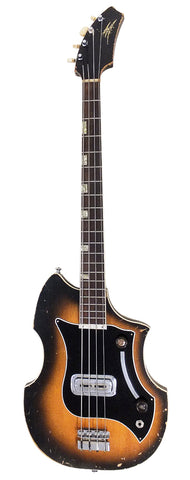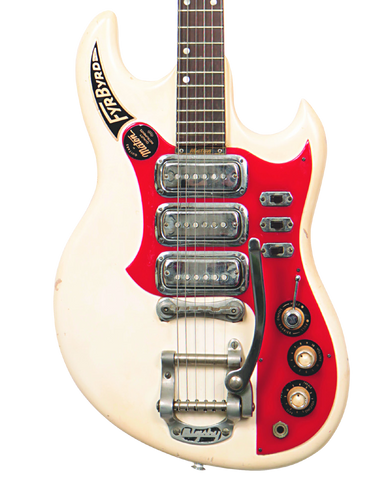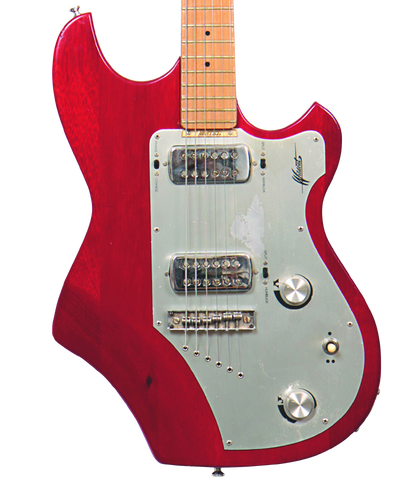The history of the Maton brand starts in the early 40’s, when it was funded by Bill May. Bill had several occupations that put him in a good position to get on board the guitar revolution that occurred, especially after world war II. At the time he started his company he was a woodworker teacher, a luthier and a jazz musician, and he called the new company “Maton Stringed Instruments and Repairs”.
Since there is no precise date for when he started the endeavor, the year of 1946 assumes importance as it’s the year he released the first Maton instrument to be commercially available. That was also the year that his brother joined him in this adventure. Reg was also a woodworker and together they made the business grow.
The business kept going well and in 1949 they eventually moved to Canterbury, where they kept producing instruments. Now since we are focused on the electric guitars part of the story, we will fast forward into the 60’s when they started to produce electric guitars and amplifiers. The amplifiers would be released under the brand Magnetone.
It is in the 60’s that Maton will be more involved in releasing new electric models, both guitars and basses, and from there on the line of guitars keeps getting smaller until they stop producing.
In 1989 they moved the company into Baywater, and moved from there to the current factory in Clarice Road in Box Hill in 2003. This move was already under the direction of Bill’s daughter Linda and his son in law Neville Kitchen as unfortunately Bill passed away in 1993 at the age of 75.
Maton is the most important guitar company in Australia. They are even responsible for the first bass to be commercially manufactured in Australia, the Big Ben. They were also pioneers in Australian sponsorship's to rock bands, like “The Strangers”, creating for them the “El toro” guitar and bass models, and have managed to keep the business a family business.
Today they make fine acoustic guitars, but have stopped making electric guitars all together somewhere after the year of 2020.
Now let's turn our focus into the instruments themselves and take a look at 7 instruments that marked the journey of Maton in the electric world.
Big Ben Twin Bass 66 – 1963 Brochure

Before we dive completely on the guitars lets just look at the first commercially available bass “Made in Australia”, the Big Ben. For me this is actually one of the coolest basses coming to us from the sixties.
This Bass was introduced into the market in 1959, and discontinued in 1063, counting just 235 units ever made!
First let's focus on the outline of the body. For me it's an elegant inspiration from the violin shaped instrument family. Obviously I don’t know if the “violin” shape was the base of the design but the round bottom and the two middle counter curves, called C-ribs in the violin world, point me in that aesthetic, but here as just an influence that is treated in a very modern way. The lines of the body are fluid and dynamic, and the headstock matches them with its curves.
The pickguard is where I have some disagreement. It was designed to end at the neck end, like all other Maton instruments of the time, and it does not “embrace” the neck, and as such it cannot follow the body curves creating some dissonance at this area.
Love the metal shapes of the pickup, and in all this is for me a very attractive design, and an instrument I would love to have in my collection.
Here is some copy from a 1963 brochure:
“Modern music today, calls for the right backing, especially by the bass man. The Big Ben Twin opens up a new variety in medium and low frequency response. The new MATON Bass now takes a lead in the group as a featured instrument. By the touch of a switch. Deep low resonant tones – solos brought forward – walking bass patterns easily played.
- Two “Magnetic” Bass Pickups
-Fingertip controls
-Positive neck adjustable by the MATON ADJUSTABLE TRUSS ROD
-Burnished fingerboard and frets
-Sturdy fittings
-Solid Leather strap
-Scale 30 ½ inches (confirm)
Colors: Black and cherry and it was £87.10
Super Solid

One of my favorite Maton electric designs is the SuperSolid, or EG75. It was released in 1959, and its production lasted until 1962 with 533 guitars being made during that period. Its price tag was 45.10, australian.
The body was made of maple and there was the possibility of having a tremolo.
The original bridge is in all similar to the first Les Paul trapeze bridge design, but this was a flat top design body. The neck is unusually deep into the body joining it at the 14 fret, unlike the more traditional 17 fret. This is in part because of the shorter scale, 23.5’’ and in part obviously to with the cutaways design. Bill could have easily made them join the neck at the 17 fret, but he decided to do it this way. Influenced by the acoustic construction maybe?
This guitar features what would be called the shark bite, something Maton used in various models, and that is a continuation of the C-curves we saw in the Big Ben Bass.
Of the two original color combos I very much prefer the one with the white body, that combined with the red plastic pickguard pulls me into the 60’s. The other was black with white guard. This model is nicknamed goldline due to the edge carve being painted gold.
From the catalog:
“Specially designed for adult and young musicians with small hands. Reinforced neck, short scale, comfortable modern cut-away body style.
Dual high fidelity pick-ups afford full range in tone and volume.
Colors: White with red guard, Black with white guard.
Model EG75
Complete in carrying case £50.10
Fitted with Bigsby vibrato unit £73.10
Flamingo 555

The Flamingo guitar is an offset design style body facing forward. The headstock is a six in line design, and the body as a custom tremolo. First I would like to point to the bridge design, a simple metal bar that can only be adjustable in its height and in some early examples an acoustic style wood bridge with a bone saddle.
The controls seem to be too closely packed, but the original knobs are just a delight, and the selector switch also is very 60’s, and we will see it in other models. Pickups are fully encased in a stylish metal cover and overall this is an attractive instrument. One potential area of design conflict could be between the body outline and the pickguard, as the pickguard has completely different lines from the body lines but it kind of works.
Its production started in 1963 and was discontinued in 1965, with 1335 coming out of the production line.
From the catalog:
“Ultra modern styling, featuring molded plastic-finish. Double cut-away with fall-away style to the right for easy access to every position and fret.
Twin “Magnametle'' pickups, individual string poles, perfect balance. New easy action Tremolo Arm. Strong rugged construction.
Quick action pick-up. Change Switch. Tone and volume controls.
Slim 21-fret neck with the Maton adjustable Truss Rod assuring perfect neck control.
Colors: Flamingo Red, Deep Purple
Price: £54
Fyrbyrd – 1963 Brochure

Next let's look at one of the most expensive Maton electric of the time, and one of the most compelling designs, the FyrBird. This model was released into the market in 1962 and discontinued in 1966, with 1186 units being produced.
The body is an offset style, double cutaway and the shark bit. The outline works amazingly well despite all that’s going on. It features three single coils, encased in metal and with the pickup frames also in metal. The bridge is a metal block, compensated for each string and only adjustable in its height and the guitar was fitted with the famous Bigsby.
One of my favorite color combos is the “Moon” white, which featured a red pickguard that worked particularly well with all the chrome parts.
Each pickup had an off switch and we also had a volume, tone and a “sound barrier” switch.The headstock is a six in line, and its outline can be seen in several models, although I don't really think it work particularly well in this model, it's too heavy visually and it “pull down” the guitar.
In all the historic hardware we can see in this guitar makes it a vintage jewel, one of the coolest details for me is the plate that has the model name on the horn. That's real vintage stuff there!
From the catalog:
“Slim, free action neck with MATON ADJUSTABLE TRUSS ROD CONTROL
Three new MATON “Magnametle” PickUps completely shielded, location designed.
Individual silent switch to each pickup
Sound barrier switch for the “break thru” solos
American Bigsby Tremolo Arm
Volume, Treble and Bass Voicing Controls
There’s real fire in the Fyrbyrd
Fyrbyrd 620 Colors: Fyre Red, Moon White”
Price £101.17
Wedgtail S/2

Now let's look at the Wedgetail model. We are on the end of the sixties when this model come out, 1968. The body was made of Honduras mahogany with a gloss finish, and this guitar was discontinued in 1973.
The body of this guitar has unusual shapes. The bottom is flat, and the outline then takes us to two very pronounced cut-aways. But still the most original and thought provoking idea in this instrument is the headstock, with three standard electric tuners on the bass side, and on the treble side three on a slot, like the classic guitars. Focusing back on the body, in this instrument I don’t think the pickguards are an element integrated with the rest of the guitar, they almost feel an “add on”.
The Bigsby vibrato present in the guitar is recessed so that a better string break angle can be achieved.
From the catalog:
“A new sensational “First” by Maton. The Wedgtail offers full professional features at a competitive price. Smart design, great new sound, exciting flare shade finish. Slimline neck fitted with the MATON DOUBLE THRUST ADJUSTABLE TRUSS ROD. Smooth low action; a playing pleasure. Body of choice Honduras Mahogany. Twin “Ultrasound” Pickups. Separate tone and volume controls, all serviced by a removable back panel. Recessed Bigsby Vibrato unit. New Alloy Micromatic Bridge. Enclosed all metal machines. Lasting super gloss Finish.
Colors: Flare sunburst, Flare red
Scale: 24 ¾ inches
Body size: 19’’ long, 12 ¾’’ wide, 1 2/8’’ thin
Wildcat WSG/6 – Full body and cutaway model

The Wild cat had two models, one normal and one with a cut-away in the back. I like both, but the one with the cut away one is just too cool and rebel to pass on. This model was introduced in 1974 and discontinued in 1976, with 109 instruments produced, so not such a great sales champion but still worth mention in this list.
We are Now in 1975, and things are more refined in this model compared to the early instruments as time moves on and trends come and go. The headstock is now a 3+3 original shape, and the outline of the body is pretty standard in the non-cutaway model.
One of the highlights of this model was the pickguard, made in Duralium, an alloy of aluminum and copper, and was supposed to give the tone more high end. It's visual effect combined with the choice of knobs, small sliding switches and the way the strings go into the body give this guitar a very polished and refined look. Reminds me of high fidelity devices.
The sliding switches are for split effect and phase switching. I love the small prints in the pickguard, but I do not like the small straight line in the lower horn.
From the catalog we could read:
“A new concept in guitars. New sounds. Compact styling and great playing ease. A smooth, snug fitting” mahogany body, white maple neck with new “Rigid” double thrust truss rod. Fingerboard finished in iron hard enameline for super fast action. (Enameline was a brand of enamel.)
Features: Two hipower split-humbucking pickups fitted with slide switches for quick split sound rhythm change. New phase change effect. Various pick up changes can be mixed for effects. Volume, tone controls. Smooth action pick up switch. Duralium mounting plate for extended Highs. Positive action enclosed machines. Adjustable metal bridge.
Size: Total length 1m (39’’)
Width 33 cm (13’’)
Depth 45mm (1 ¾)
Weight: 3.17 kg (7lbs)
Scale 25 ½’’ 21 frets
Colors: Wild cherry, natural mahogany
MS500/12 STD also 6 string

One of the last Maton electric designs is the MS series, in this case I choose to show the 500/12 STD, the 12 strings version, semi-hollow guitar. It's a classy double cutaway, where the cutaways fall into the world of the gibson 335.
I think it's a very accomplished design, maybe with an oversize pickguard for a body design that called for a bit more restraint in details.
Body: Old Maple
Cap: Rock Maple or Blackwood
Neck: Old Maple
Fingerboard: Rosewood with dot inlays, jumbo fret wire, 12 inches radius
Paint: High gloss – ultra blue, cherry, black, natural and wine red sunburst
Binding: Single white around body and f-hole
Nut: 42mm
Scale 24.5 inch
Pickups: Bridge Maton MMH1 humbucker (coil tap)a alnico V
Neck Maton MMS1 Single coil Alnico V
Controls: One volume control, one tone control 3 way rotary switch, one coil tap switch
Hardware: BB Stone chrome stop tailpiece and bridge Chrome Grover 12 string machine heads.
And so our journey reviewing the adventure of Bill and Maton guitars brand in the world of electric guitars comes to an end. I will keep my hope for a future reissue of some of the classic models, but it seems a very long shot!